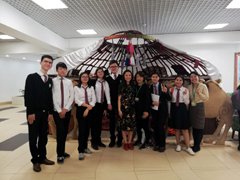Searching for Ways to Attract More Japanese Learners
The Kazakhstan-Japan Center for Human Development, Nur-Sultan
SAITO Satoko
1. The Current Status of Japanese-Language Education in Kazakhstan
In this report, I would like to write about the state of Japanese-language education in the capital of Kazakhstan, Nur-Sultan, renamed from Astana in March. The Kazakhstan-Japan Center for Human Resources Development (hereinafter “KJC”) has its main office in Almaty, the former capital of Kazakhstan, and has traditionally been the center of activities. The Nur-Sultan office is carrying out its activities in cooperation with the Almaty office. The office is located in within the Kazakh Humanities and Law Institute, commonly known as Kazguu, and operates three classrooms and one off-campus class on Saturdays at the National Academic Library. There are two full time instructors, consisting of myself as the Japanese-Language Specialist (hereinafter “Specialist”), and one Kazakhstani member, and two part time instructors, also one Japanese and one Kazakhstani member. Together we run five classes for 52 students covering the starter through early intermediate levels of Japanese.
The only university Japanese program in the country is found at the Department of Oriental Studies of the L.N. Gumilyov Eurasian National University (hereinafter the “Eurasian University”), with 22 students currently learning, and one or two graduate students studying at the university’s graduate school. There are also 15 higher secondary school students in grades 9 and 10 who have been studying Japanese at one of the national Nazarbayev Intellectual Schools (hereinafter “NIS”) since September 2018. That course was launched with the cooperation of the Japanese-Language Specialist dispatched to Almaty and the Embassy of Japan in Kazakhstan.
Furthermore, there are 41 students learning Japanese at the unofficial group called “JAPAN CLUB” at Nazarbayev University. There are also clubs studying Japanese culture and language at the NIS International Baccalaureate Programmes (hereinafter “NISIB”).
Finally, there are three private language schools that teach Japanese, one of which is dedicated to teaching Japanese and has a native Japanese teacher working there.
Accordingly, due to the shortage of educational institutions teaching Japanese and the lack of native Japanese instructors other than those at the KJC and the one private school, the most urgent challenges are the establishment of official Japanese courses at higher secondary schools and universities, and the development of Japanese-language teachers.
2. Searching for Ways to Attract More Japanese Learners – Measures to Date and Future Plans
February 21, 22: A seminar for teachers was held jointly by the Almaty and Nur-Sultan offices of the KJC at the Eurasian University in Nur-Sultan.
March 2: The 21st Japanese Speech Contest in Kazakhstan was held in Almaty and 14 contestants gave speeches on themes of their choosing.
March 6: A demonstration class was held in NIS in preparation for the Tokyo Olympics using a video created by the city of Kashihara, Nara prefecture, the host city for the Kazakhstan team, showing a tour of that city.

The Japanese-Language Specialist introduces a school bag factory in Kashihara in a demonstration class.
During March: I observed classes run by the full time and part time teachers at the KJC and held discussions with them to provide feedback.
April 16: I visited School No. 16 in Nur-Sultan with a member of the Embassy’s Japan Information and Culture Center, an interpreter and the Japanese-Language Specialist to speak about Japan. Yo and Yogurt is a work using Cyrillic letters that addresses Hiragana association, or how it relates to the Russian language, in order to memorize Hiragana.

Hiragana Association Yo and Yogurt
May 5: We took the opportunity of the visit by Professor Emeritus Hidasi Judit of Budapest Business School (Hungary) to Kazakhstan to talk with her about foreign language education in communication studies and about Japanese-language education in Hungary. The event was attended by members from the Embassy, the Казахстанская ассоциацияпреподавателей японского языка в РК (Japanese teachers association in Kazakhstan), and other interested parties.
May 8: I visited the Japan Club at NISIB along with members of the Embassy’s Japan Information and Culture Center to give an open talk on Japanese culture and demonstrate Origami (paper craft).

In front of the yurt at the entrance hall of NISIB
The leader and members of the Japan Club.
There was also a concert of anime and game music performed by Japanese musicians to which a great number of fans of anime music attended. Information on these and similar events are all shared via social media of each KJC class, along with information from the Japanese Association and the Embassy’s liaison network to encourage as many people as possible to participate in events on Japanese culture.
Our coming plans include a two-day seminar for teachers to be held after the upcoming Japanese-Language Proficiency Test (JLPT) in Almaty in July. The Nur-Sultan office is also planning to host public hours once per week to introduce Japanese culture, as well as teacher’s seminars in June and July. I intend to continue working hard to ensure as many people as possible take an interest in Japan and the Japanese language.
- What We Do Top
- Arts and Cultural Exchange [Culture]
- Japanese-Language Education Overseas [Language]
- Japanese-Language Education Overseas [Language] Top
- Learn Japanese-language
- Teach Japanese-language
- Take Japanese-Language Test
- Know about Japanese-language education abroad
- The Japanese-Language Institute, Urawa
- The Japanese-Language Institute, Kansai
- Japanese-Language Programs for Foreign Specified Skilled Worker Candidates
- Japanese Language Education for Japanese Children Resident Overseas and for the Descendants of Migrants
- Archives
- Japanese Studies and Global Partnerships [Dialogue]
- JF digital collection
- Other Programs / Programs to Commemorate Exchange Year
- Awards and Prizes
- Publications
